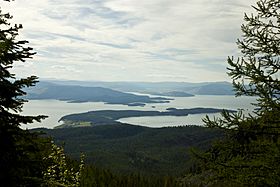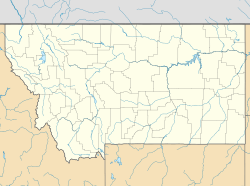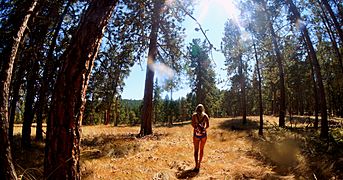Wild Horse Island facts for kids

Flathead Lake with Wild Horse Island visible in the distance
|
|
| Geography | |
|---|---|
| Location | Flathead Lake |
| Coordinates | 47°50′43″N 114°12′54″W / 47.84528°N 114.21500°W |
| Total islands | 1 |
| Area | 2,163 acres (875 ha) |
| Highest elevation | 3,749 ft (1,142.7 m) |
| Administration | |
|
United States
|
|
| State | Montana |
| County | Lake |
| Indian Reservation | Flathead Indian Reservation |
| Additional information | |
| Official website | Wild Horse Island State Park |
Wild Horse Island is the largest island in Flathead Lake. This lake is the biggest freshwater lake in Montana. For hundreds of years, the Salish-Kootenai used this island. They kept their horses here to protect them from being stolen by other tribes. The island is about 2,164 acres in size.
From 1872 to 1904, the island was part of the Flathead Indian Reservation. Later, it was divided into smaller plots of land. Some people tried to farm on the island, but it did not work out.
Contents
Protecting Wild Horse Island's Nature
Between 1910 and 1915, settlers on the island cut down many old trees. They also brought in new types of grasses and plants. These new plants have taken over much of the natural short-grass prairie. This prairie is very important for animals that eat plants.
The short-grass prairie on Wild Horse Island is one of the last few left in Montana. Because of this, people work hard to protect it. They manage the number of animals on the island. This stops the grasses from being eaten too much or disappearing.
Managing Bighorn Sheep
One example of animal management is with the bighorn sheep. Their population is kept at about 100 sheep. In 2014, there were between 160 and 200 sheep on the island. To help the prairie, Montana Fish, Wildlife, & Parks moved 59 sheep. They were taken to other herds in Northwest Montana.
Wild Horse Island is known for its large bighorn sheep. Between 2015 and 2018, three of the top five bighorn sheep ever recorded by the Boone and Crockett Club came from this island. The Boone and Crockett Club tracks big game animals. This helps them measure how well wildlife is being managed.
Wild Horse Island State Park
Since 1977, Wild Horse Island has been a state park. It is located near Big Arm Bay. The island is home to many different animals. You can find bighorn sheep, mule deer, waterfowl, and bald eagles here.
As of 2013, there were five wild mares (female horses) and one gelding (male horse) on the island. You can only reach the island by boat. It is also only for day visits, meaning you cannot stay overnight.
The island is managed by Montana Fish, Wildlife & Parks. It is located within both the Flathead Indian Reservation and Lake County, Montana. There are 56 private lots on the island. Each lot is about 1 acre in size. The highest point on the island is 3,749 feet high. This is 853 feet above the island's shores.
Island Climate and Shape
A study over 25 years showed that Wild Horse Island gets about 15.7 inches of rain each year. The average daily temperature changes from 24 to 66 degrees Fahrenheit. In colder months, temperatures can drop below 5 degrees Fahrenheit. In hotter, drier months, afternoons can be above 90 degrees Fahrenheit. Overall, the island has temperatures below freezing for about two-thirds of the year.
Wild Horse Island was shaped by a large ice sheet called the Cordilleran Glacier. This glacier gave the island its varied landscape. The shores of the island are 2,900 feet above sea level. The glacier also formed six peaks in the center of the island. These peaks range from 3,277 to 3,745 feet high. They have rugged northern faces and steep southern cliffs.
Meadows spread across the western and southern shores. Grasslands cover the southeast part of the island. The northern side of the island has forests of Ponderosa pine and Douglas fir trees.
Gallery





